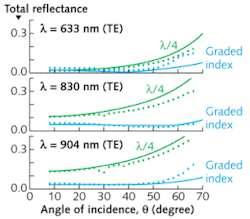SOLAR CELLS: ‘Near perfect’ antireflection coating boosts solar-cell efficiency

Silicon solar cells hold promise for clean, renewable energy–and would be much more common as an alternative source of electricity if their cost was not so high. Scientists are racing to increase the efficiency and thereby reduce the cost of solar cells (see www.laserfocusworld.com/articles/343734). Now, a group of physicists and engineers at Rensselaer Polytechnic Institute (Troy, NY) has crafted a coating that greatly increases the amount of sunlight available for conversion to electricity in a solar cell. The antireflection (AR) coating attacks the efficiency problem two ways: by helping solar cells absorb a wider range of solar wavelengths, and by increasing the range of angles of incidence for which the light is absorbed.
Untreated silicon solar cells typically reflect back a third of the sunlight incident on them, light that is then not available to convert to energy. This absorption inefficiency is one of the major reasons that solar-cell technology is not economically viable. While AR coatings can be used effectively to achieve very low reflectance values, they are effective only across limited bandwidths and at small angles of incidence. Rensselaer physics professor Shawn-Yu Lin and colleagues developed a graded-index AR coating to minimize reflectance across the visible and infrared part of the solar spectrum, from wavelengths of 400 to 1600 nm. The coating also collects sunlight at a much wider range of angles of incidence than standard AR coatings.
The key to the coating is a multilayer structure that gradually increases the index of refraction with depth. The design consists of seven layers measuring 60 to 160 nm thick, made of silicon dioxide (SiO2) and titanium dioxide (TiO2; see Fig. 1). The bottom two layers are TiO2, followed by three middle layers of cosputtered SiO2 and TiO2. The top two layers consist of slanted nanorods of SiO2 with very low refractive indices of 1.22 and 1.09, the tilt angle of which is created using an oblique-angle deposition technique that precisely determines the refractive index.
Lin and his group characterized the total reflectance of the AR coating using several lasers, including an argon laser at wavelengths between 454 to 514 nm, a helium-neon laser at 633 nm, and laser diodes at wavelengths from 780 to 1060 nm and 1260 to 1600 nm. They compared the total reflectance spectra of an untreated bare silicon sample to that of a quarter-wave AR-coated sample, and that of the new graded-index AR coating sample, with the lasers incident at an angle of 8° from the normal.
Lowest reported reflection
Taking into consideration the sharp change in reflectance at 1550 nm due to silicon’s optical transparency, the team deduced that the untreated silicon reflected 31% to 49% of the incident light. The quarter-wave AR coating had a consistently low reflectance of less than 3% around 550 ± 50 nm, but exhibited a strong increase in reflectance at higher wavelengths. The graded-index AR coating exhibited a consistently low reflectance of 1% to 6% for wavelengths across the visible and infrared part of the spectrum. According to the researchers, the average reflection of 3.79% is the lowest ever reported, and the first to consistently cover that wide of a wavelength range and range of incident angles.To measure angular dependence, Lin’s team took measurements of the seven-layer film while rotating the sample mounts, finding that the graded-index AR coating maintained a consistently low reflectance (2% to 5%) from angles of 0° to 60° from the normal (see Fig. 2). On the contrary, the quarter-wave AR sample loses much of its incoming light, reflecting 11% at an angle of 8° and 26% at 60°.
According to the researchers, the overall solar-to-electric efficiency improvement over bare silicon solar cells would be boosted from the 20.5% obtained with a quarter-wave coating to 42.7%. Nevertheless, more work is needed to overcome the fragility of the graded-index coating and make it commercially viable.
REFERENCE
- M. Kuo et al., Optics Letters 33(21), 2527 (2008)
About the Author
Valerie Coffey-Rosich
Contributing Editor
Valerie Coffey-Rosich is a freelance science and technology writer and editor and a contributing editor for Laser Focus World; she previously served as an Associate Technical Editor (2000-2003) and a Senior Technical Editor (2007-2008) for Laser Focus World.
Valerie holds a BS in physics from the University of Nevada, Reno, and an MA in astronomy from Boston University. She specializes in editing and writing about optics, photonics, astronomy, and physics in academic, reference, and business-to-business publications. In addition to Laser Focus World, her work has appeared online and in print for clients such as the American Institute of Physics, American Heritage Dictionary, BioPhotonics, Encyclopedia Britannica, EuroPhotonics, the Optical Society of America, Photonics Focus, Photonics Spectra, Sky & Telescope, and many others. She is based in Palm Springs, California.

